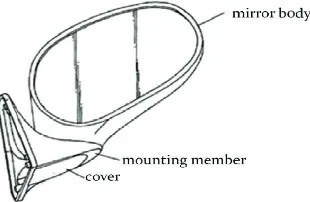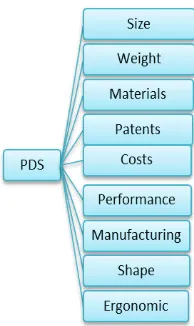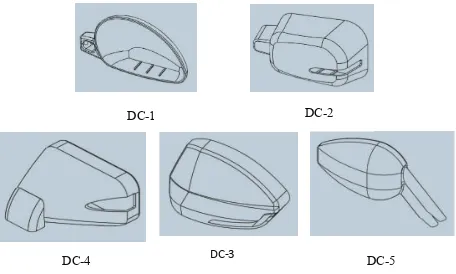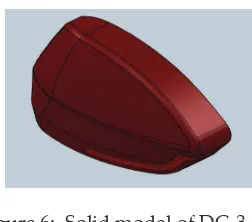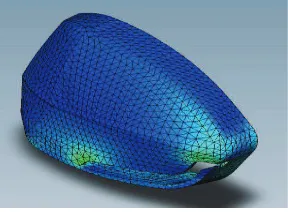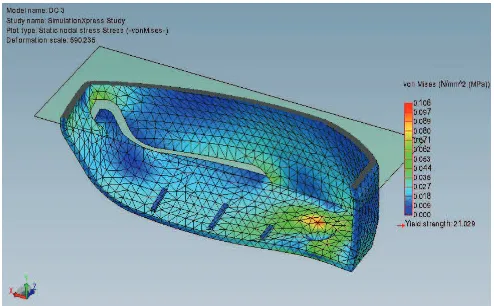DEVELOPMENT OF CONCEPTUAL DESIGN OF CAR HOUSING SIDE MIRROR USING INTEGRATED APPROACH
Hambali, A., Faiz, R,Tajul, A.A., Baharuddin, A.B., and Dan, M.M.P., Faiz, R.
Department of Design Manufacturing, Faculty of Manufacturing Engineering, Universiti Teknikal Malaysia Melaka (UTeM),
Hang Tuah Jaya, 76100 Durian Tunggal, Melaka, Malaysia
Author’s Email: [email protected]
ABSTRACT: This paper presents the development of automotive car housing side mirror using integrated approach. The car housing side mirror was chosen to illustrate the application of integrated approach. Various product development stages were conducted which initially from market investigation to concept development stage. Conceptual design stage is a main design stage which is analytical hierarchy process (AHP) was selected as a decision making method to determine the most appropriate design concept. Finite Element Analysis (FEA) was employed to analysis design based on static analysis for determining the strength and performance of the design. The result shows design concept 3 (DC-3) is the preferred choice since it has the highest value among the ive alternatives with a value of 0.4701 (47%).
KEYWORDS: Car housing side mirror, integrated approach and inite element analysis (FEA).
1
1.0 INTRODUCTION
ISSN: 1985-3157 Vol. 6 No. 1 January-June 2012 32
2
the mounting member are combined to form a side body type side view mirror. Thus for car housing side mirror need to consider the factors that customers needed such as the function, performance, materials selection, ergonomic and so on (Fu and Yongkang, 2008). In literature review from journals and website, there were the various types of car housing side mirror that shown, depending on the car brand. In general, A housing side mirror is fixed securely to the base. A side mirror is operatively secured to the housing at the opening. The side mirror contains a main viewing and a spotting mirror portion. The main viewing portion and the spotting mirror portion are fabricated from a unitary structure. The side mirror is a reflective element and defines a main viewing portion of one curvature and a spotting mirror portion for viewing the blind spot which is defined by having a radius of curvature less than the main viewing portion. Both viewing portions of the mirror are an integral to one unitary structure that is fabricated from a sheet metal such as steel, stainless steel, or aluminum (Fu, 2008). The perspective view of side mirror is shown in Figure 2.
Figure 1: The perspective view of the car side mirror (Fu and Yongkang 2008).
2.0 METHODOLOGY OF RESEARCH WORK
Total design or integrated approach is the systematic activity necessary, from the identification of the market/user need, to the selling of the successful product to satisfy that need an activity that encompass product, process, people and organization (Pugh, 1991). The integrated also referred as the product delivery process or the product development process, as called as PDP. Integrated having a several core of activities, which is defined as design core, consists of market or user needs, product design specification, conceptual design, detail design, manufacture and sales. All the design starts by fitting into an existing market or create a market of its own. An analysis of existing product will show that the main design begins from market to sales. The achievement of the integration of technological or non-technological subject material in an effective manner is enhanced by having a visible operational structure. An analysis of any existing product will reveal that the main design flow is from market to sales. This design also called design core. At all stages, the design core activity is operatin smoothly, mean in later inspection, the stages will to have been done smoothly. So the main design can be reversed at any point in the design activity, but operating within the design core systematically would minimize unnecessary iteration. Basically, the design flow used in this paper is based on the Pugh’s method, (1991). The Pugh method consists
six stages namely market investigation, product design specification (PDS), conceptual design, detail design, manufacture and sales as displayed in Figure 2.
ISSN: 1985-3157 Vol. 6 No. 1 January-June 2012 34
4
3.0 DEVELOPMENT OF SIDE MIRROR
Development of side housing mirror based on integrated approach as depicted in Figure 2. The development process is discussed as below.
3.1 Market investigation
Market investigation is the first phase in product development process and it is essential in determining the success of a product. There are many products which have been reported as unsuccessful in the marketplace because they do not meet the customer’s expectation (Cooper, 2003). It is important to implement this tool which can ensure a better understanding of the customer needs and requirements.
3.2 Product Design Specification (PDS)
PDS is a document prepared early in the in product development process that controls the design and manufacture of the product (Pugh, 1991). The PDS is very important to the success of the product development process because it is so influential in describing the requirement of the final component (Wright, 1998). To consider the right development process of the car housing side mirror, there are nine elements of the PDS were considered as shown in Figure 3. The detail of PDS is not discussed in this paper.
Figure 3: Elements of PDS for development of car housing side mirror
3.3 Conceptual design stage
5
process of the product design specification. There are three components, which is concept generation, concept selection and concept development. Besides that, the selection process to determine the most optimum design concept is performed by using analytical hierarchy process (AHP) approach.
3.3.1 Concept generation
The design of a car housing side mirror is generated by addressing at the issues surrounding the creation and generates ideas in order to achieve the best selection of product design. For this step, brainstorming is used to generate ideas to meet the product design specification. Several factors need to be consider when designing the car housing side mirror such as what is the type of car that have been used, the suitable material selection that need to determine, the safety element that need to apply in each design, and the shape of side mirror that consist the human attraction such as aesthetic values and so on.
3.3.2 Concept evaluation
After implementing several design steps that have been discussed previously, there are five design concepts (DC) of the car housing side mirrors. Thus, it is necessary to choose the best design concept for further development. The characteristic of each design concept is explained below in decision options. After that, the selection process to determine the most optimum design concept is performed by applied the Analytical Hierarchy Process (AHP) approach. The AHP, developed at the Wharton School of Business by Saaty (1980), is a most helpful concept on decision making process to help people make a best decision. After implement several steps in product development process, there are five design concepts (DC) of car housing side mirror produced as shown in Figure 4.
-2 -1
-3
-4 -5
DC-2 DC-1
DC-3
DC-4 DC-5
ISSN: 1985-3157 Vol. 6 No. 1 January-June 2012 36
Figure 5: Hierarchy model for the selection of design concept
Based on AHP method (Hambali et al., 2008), Table 1 shows the design concept 3 (DC-3) that has the highest value (0.4701 or 47%) among the other design concepts that is appropriate for further development. The second highest is the design concept 2 (DC-2) with a value of 0.3003 (30%), and the lowest value or last choice is the design concept 4 (DC-4) with a value only 0.2509 (25%). DC-3 is the preferred choice since it has the highest value among the five alternatives.
Table 1: Results of selection
No Best Selection
1 DC-3 0.4701
2 DC-2 0.3003
3 DC-1 0.2442
4 DC-5 0.2599
5 DC-4 0.2509
3.3.4 Concept development
3.3.3 Selection process using analytical hierarchy process
The best decision of conceptual design of side mirror housing is determined using AHP. After implementing several steps in product development process, there are five design concept of car housing side mirror produced as shown in Figure 4. Thus, it is necessary to choose the most appropriate design selection by using AHP. Based on Figure 4 and AHP steps, a four level hierarchy decision process is displayed in Figure 5.
3.3.4 Concept development
After finishing the selection process by using AHP approach, the concept selection revealed that the best selection is concept design 3, which is required to further develop and analyse. Several factors need to be considered when designing a car housing side mirror such as the material cost, safety, performance, size and so on. From this considerations, design concept 3 (DC-3) was become the best selection among the others design concept.
4.0 ANALYSIS OF CAR HOUSING SIDE MIRROR
The analysis was focused for the design concept three (DC-3) (Figure 6). It is because the design concept three (DC-3) has been selected as the most appropriate design concept based from the AHP results. The design concepts were analyzed by using SolidWorks SimulationXpress (Anony, 2011). It is the one of the finite element analysis (FEA) software that achieved for testing part designs quickly and easily within the 3D mechanical design software. The analysis in this software more focuses on the stress analysis that contains stress, deformation and displacement simulation. The results presented the stress location and minimum stress that could be summarized the best selection design concept of the car housing side mirror.
Figure 6: Solid model of DC-3
ISSN: 1985-3157 Vol. 6 No. 1 January-June 2012 38
Table 2: Mass properties
Material ABS
Mass 0.21516 kg
Volume 0.0002858 m3
Force 1 N
Stress 9.09493 10-5 N/mm2
Displacement 0.0455341 mm
The mesh information gathered from SolidWorks drawing. It generates automatically for designer to easily present the result of finite element analysis. This mesh is programmed with contain the material and structural properties which define how the structure will react to certain loading conditions. Nodes are assigned at a certain density throughout the material depending on the anticipated stress levels of a particular area. Figure 7 shows the mesh of the DC-3. Using SolidWork simulation express, design analysis for side housing mirror was performed. Figure 8 shows the stress analysis with mesh of DC-3 with the fixture and direction of force. The blue colour of von mises displayed the minimum stress are impacted on the surface, while the red colour is the maximum stress that has been applied.
ISSN: 1985-3157 Vol. 6 No. 1 January-June 2012 39 Figure 8: DC-3 Simulation Xpress Study of stress analysis with mesh (cross
section view)
5.0 CONCLUSION
Development of the car housing side mirror was explored in this paper by using integrated approach. Various product development stages have been conducted such as market investigation, product design specification, conceptual design stage and detail design stage. The finite element analysis (FEA) has been performed to determine the stress analysis of the design. Determination of the best result of conceptual design is performed using AHP. AHP showed that design concept 3 (DC-3) is the most appropriate decision since it has the highest value among the five alternatives with a value of 0.4701 (47%).
6.0 ACKNOWLEDGEMENTS
The authors wish to thank Universiti Teknikal Malaysia Melaka (UTeM) for supporting this research.
7.0 REFERENCES
Cooper, L.P. (2003). A research agenda to reduce risk in new product development through knowledge management: A practitioner’s perspective. Journal of Engineering and Technological Management, 20(1-2), 117–140.
Hambali, A., Sapuan, S.M., Ismail, N and Nukman. Y. 2008. Use of
Int. J. Design Engineering,
ISSN: 1985-3157 Vol. 6 No. 1 January-June 2012 40
Hambali, A., Sapuan, S.M., Ismail, N and Nukman. Y. 2008. Use of analytical hierarchy process (AHP) for selecting the best design concept. Jurnal Teknologi 49 (A): 1-18.
Okudan, G.E. and Tauhid S. (2008) Concept selection methods – a literature review from 1980 to 2008. Int. J. Design Engineering, Vol. 1, No. 3, pp.243-277.
Pugh, S., 1991. Integrated: Integrated Methods of Successful Product Engineering. Wokingham, England: Addison Wesley Limited.
Saaty, T.L., 1980. The Analytic Hierarchy Process. McGraw Hill, NewYork, Saaty, T.L., 1980. The Analytic Hierarchy Process. McGraw Hill, NewYork, NY. Wright, I., 1998. “Design Methods in Engineering and Production Design.” London.
McGraw-Hill.
Anonymous, 2008. SolidWorks. http://www.solidworks.com./. Accessed on 12 May 2011.
